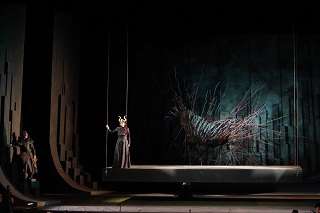|
Back
Conquest, Love & Suicide in Asia Minor Piacenza
Teatro Municipale
01/20/2023 - & January 22, 2023
Antonio Vivaldi: Tamerlano, ovvero la morte di Bajazet, RV 703
Filippo Mineccia (Tamerlano), Bruno Taddia (Bajazet), Delphine Galou (Asteria), Federico Fiorio (Andronico), Shakèd Bar (Irene), Giuseppina Bridelli (Idaspe), Dacru Dance Company
Accademia Bizantina, Ottavio Dantone (conductor)
Stefano Monti (stage director, sets, costumes), Eva Bruno (lighting), Cristina Ducci (videography), Marissa Ragazzo, Omid Ighani (choreography)

(© Cravedi)
Piacenza is the westernmost city of the beautiful region of Emilia-Romagna in central Italy. Its opera house was built in 1804 and has a capacity of 1120. With a population of 100,000, it is rather surprising that they have an opera house at all, let alone that it would present an opera as obscure as Vivaldi’s Tamerlano, ovvero la morte de Bajazet as opposed to Tosca, La bohème, Carmen or La traviata, as they would in North America or elsewhere in cities tenfold Piacenza’s population.
So how is this achieved? The secret is that several small Italian cities collaborate with other cities, in a brilliant initiative advanced three decades hence. The cities are also in the Emilia-Romagna region, such as Ravenna, Modena and Reggio Emilia, as well as the Tuscan city of Lucca. With theatres of comparable capacity in each market, they share most productions each season. Piacenza’s 2022‑2023 offerings include six operas: Verdi’s Rigoletto, Il trovatore and Don Carlo; Giordano’s Fedora; Debussy’s Pelléas et Mélisande; and Vivaldi’s Tamerlano. Companies in many larger markets could not dream of mounting such alluring operatic feasts.
Contrary to the perceptions of some, Vivaldi’s Tamerlano, ovvero la morte di Bajazet (1735) also known as Bajazet, is not based on Jean Racine’s play Bajazet (1672). While Racine’s play deals with intrigue in the Ottoman court, Vivaldi’s opera treats the tragic death of the Ottoman Sultan Bayezid I (1360‑1403) during his captivity by the Turco‑Mongol conqueror Tamerlane or Timur Gurkani (1370‑1405). It is based on another French play, Jacques Pradon’s Tamerlan, ou la mort de Bajazet (1675).
Vivaldi’s opera is a pasticcio. Much of the music was borrowed from other Vivaldi operas, Giustino, L’Olimpiade, Il Farnace, Semiramide and Montezuma, while the rest is from operas by Johann Adolf Hasse (1699‑1783), Geminiano Giacomello (1692‑1740) and Farinelli’s brother, composer Riccardo Broschi (1698‑1756). Vivaldi used his own compositions for the good characters, Bajazet, Asteria and Idaspe, and borrowed other composers’ music for the villains Tamerlane, Andronico and Irene.
As is almost always the case in baroque opera, the intrigue is complex. There are four main characters: Ottoman Sultan Bajazet; his daughter Asteria; Tamerlane, who defeated and captured Bajazet and his daughter; and Andronicus, a Byzantine Prince and Bajazet’s friend and ally. There are two secondary characters: Idaspe, Andronicus’s friend and advisor; and Irene, Byzantine Princess of Trebizonde and also Tamerlane’s fiancée. Asteria and Andronicus love each other. Tamerlane loves and wants to wed Asteria and give Irene to Andronicus. Irene, who Tamerlane had never seen, is furious and joins Tamerlane’s court as Irene’s messenger.
A variety of emotions are experienced: Asteria feels Andronicus has too easily renounced her for his own political ambitions. Asteria accepts Tamerlane’s proposal to save her father, and also to get close enough to poison Tamerlane. Bajazet despises his daughter for accepting to marry the nomadic conqueror. Irene, impersonating Irene’s messenger, befriends Asteria, who informs her of her plan to poison Tamerlane. When Asteria serves Tamerlane poisoned wine, he is warned by Irene, who then reveals her true identity. A grateful Tamerlane retakes Irene as his bride. Asteria is promptly arrested and ordered to be put to death. A desperate Bajazet commits suicide. Tamerlane forgives Asteria and accepts her marriage to Andronicus.
That’s a very compact synopsis of Vivaldi’s opera. Staging such a convoluted story, even by opera standards, is an obvious dilemma. Stage director Stefano Monti chose six dancers, representing the six protagonists, to perform throughout the opera. Their moves represented the emotions expressed in the singers’ arias. Surprisingly, this was effective and not a distraction, likely thanks to the baroque formula involving a sequence of solo arias and only a few ensemble pieces. The sets were spartan, but enhanced by an original colourful videography–a welcome visual distraction. The mostly black costumes were not an attempt at historical representation. They could have been from a science fiction film. Tamerlane wore horned headgear, possibly to make the brutal conqueror look demonic. Andronicus had ancient Greek rather than Byzantine headgear.
The true glory of the production was in its singing. There were six first‑rate singers under Ottavio Dantone’s musical direction. This was a nuanced musical performance with virtuosi baroque singers. The most remarkable were mezzo Delphine Galou as Asteria and countertenor Federico Fiorio as Andronico. The latter, a sopranist, was an excellent choice to contrast with countertenor Filippo Mineccia, endowed with a darker and a more dramatic voice. Mineccia impressed in his arias, though at times his voice seemed tired, especially in the third act. Delphine Galou thrilled in her defiant aria “Svena, uccidi, abbatti, atterra.”
In the role of Bajazet, baritone Bruno Taddia’s task was more demanding dramatically than vocally. Happily, he met the challenge, movingly conveying the humiliation of a proud man and a father’s disillusionment. He was especially effective in the aria “Dov’è la figlia, dov’è il trono.” Mezzo Shakèd Bar impressed with her warm, velvety tone in the anti-heroine role of Irene. She was much appreciated by the public in the opera’s most famous aria, “Sposa, son disprezzata.” The diction of the two non‑Italian singers, French Delphine Galou and Israeli Shakèd Bar, was at par with the rest of the Italian cast.
The audience was unusually young for an opera‑going public, most likely thanks to the inherent demographic of Early Music lovers. The audience, both young and old, reacted enthusiastically, obviously thrilled by the vocal bravura in the technically difficult arias. Attuned to the public’s passionate reception, the singers rewarded them, reprising the opera’s final ensemble, “Recitativo 36,” to their rapt delight.
Ossama el Naggar
|